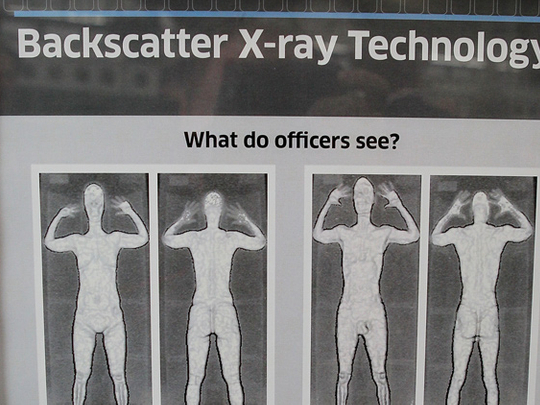
Washington: The ‘nude scanners’ are gone. The full-body scanners that used X-rays to create what look like nude images of passengers have been packed away and removed from airports across the United States. The 250 or so machines were removed about two weeks ago, before the June 1 deadline set by the Congress.
But privacy advocates aren’t satisfied, noting that the Transportation Security Administration (TSA) is still using full-body scanners that employ a different technology.
“They’ve never made a case that these scanners are better than using metal detectors or swabs to detect the use of explosives,” said Marc Rotenberg, executive director of the Electronic Privacy Information Centre, a research centre that sued the TSA in 2010 over the use of all full-body scanners.
The TSA now relies solely on millimetre-wave scanners, which previously generated similar nude images but have been upgraded to portray a generic figure on which they point out objects concealed on travellers’ bodies. The scanner is made by L-3 Communications Holdings of New York.
The X-ray scanners made by Rapiscan Systems in Torrance were removed after Congress required all airport scanners to use privacy-protecting software, such as the technology used by L-3. Rapiscan did not create the software for its X-ray scanners.
Rotenberg said he worries that the L-3 scanners may also be creating and keeping digital images of passengers. “There are lingering questions about whether the millimeter-wave devices are retaining images,” he said.
A TSA spokesman said the scanners are programmed not to retain digital images.
Transportation Security Administration chief John Pistole has delayed a plan to let passengers carry small pocketknives on planes for the first time since the September 11, 2001, terrorist attacks.
But it is clear from a speech he gave last week at George Washington University that he still supports allowing knives on planes.
Pistole delayed the change, initially scheduled to take effect April 25, after hearing concerns from a panel of airline industry representatives, including pilots and flight attendants.
But, in his speech at the university, he said, “It is the judgement of many security experts worldwide, a judgement with which I agree, that a small pocketknife is simply not going to result in the catastrophic failure of an aircraft.”
In contrast, he added, “an undetected and successfully detonated improvised explosive device will.”
Pistole noted that the United Nations’ International Civil Aviation Organisation adopted a policy in 2010 allowing passengers to carry knives with blades 6 centimetres in length or shorter on commercial planes.
Since then, Pistole said, billions of commercial airline passengers around the world have been allowed to carry such knives on foreign carriers without a reported security incident involving knives.












